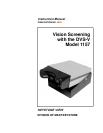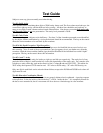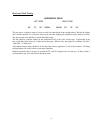
Test Guide
Subject to wear any glasses normally used when driving.
Test #1: Quick Acuity
Nine separate blocks containing three digits of 20/40 acuity letters each. The first column tests both eyes, the
second tests right eye acuity, and the third test left eye acuity. All three lines should be read, and only as
many as two digits in each column can be misread without failure. Note that we are testing both monocular
and binocular vision in one test presentation. The acuity level presented is 20/40.
Test #2: Color Vision
This is a test for gross, red/green color deficiency. If at least 3 of the 4 numbers presented are not identified
by the subject, further examination by a vision professional should be recommended. The key on the control
shows the correct numbers to be read back by the examinee.
Test #3 & #4: Depth Perception / Sign Recognition
Twelve road signs are presented on these two tests. Signs are to be identified (eleven out of twelve) as to
their meaning. Also, on each of the two presentations, one sign appears closer, one farther away from the
examinee. Both the closest and the farthest signs should be identified if the individual has normal “depth”
perception. The key on the control shows this information.
Test #5, 6, and 7: Acuity
These are separate tests of acuity for both eyes, right eye and left eye respectively. The acuity level of any
particular block of digits is read from the key card as the denominator of the acuity ratio. For example, refer
to both eyes acuity on the key card on the control to line 1 Column B and read 25=674235. This means for
20/25 acuity the response 674235 must be read. “20” refers to 20/20 acuity, “30” refers 20/30 acuity, etc.
Only one digit in each block can be missed without failure, except at the 20/100 and 20/200 levels where all
digits must be read.
Test #8: Binocular Coordination (Phoria)
This simple test determines if one’s eye muscles are properly balanced and coordinated. A passing response
to the question, “Is the dot inside or outside the box?”, will be, “inside the box.” It is completely normal for
the dot to move around a bit, but it’s movement will slow down to a limited range in a few moments.
4














